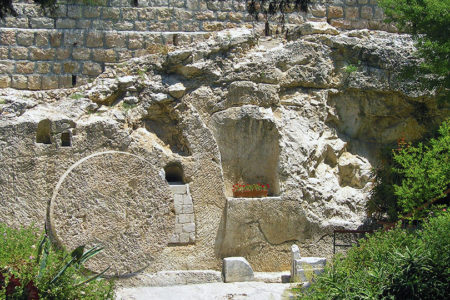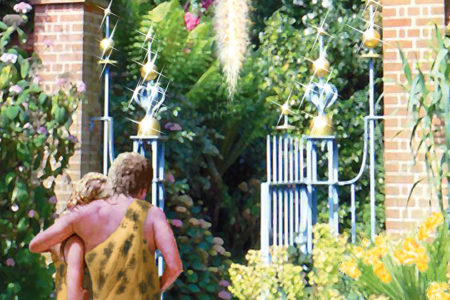The Passover Lamb
Certain words come immediately to mind as the Feast of Passover approaches. Cleaning, matzoh, and family are three of them. Cleaning begins by ridding the home of all bread products and foods containing leaven and usually ends by scouring the place from top to bottom. Matzoh is the flat, brown-striped, unleavened cracker that starts to taste like cardboard soon into the eight days of the observance. And family—well, nothing beats gathering around the seder table to laugh and eat with those you love.
Then there is the word lamb, the centerpiece of the Passover story. The holiday, which this year begins at sundown April 8, commemorates the Israelites’ Exodus from Egypt more than 3,000 years ago. And though the lamb is the single most important element of the biblical observance, it is always conspicuously absent.
With no Temple and no Jewish priesthood, there are no longer any Passover sacrifices. Instead, a bare shank bone of a lamb lies among other items on the seder plate as a reminder of the paschal lamb.
Not all Jewish people today, however, are satisfied with a lambless Passover. Several religious groups regularly attempt to bring a lamb to the Temple Mount for sacrifice, only to be turned away by Israeli police. Several years ago these groups, one of which was the New Sanhedrin Council, petitioned the Israeli courts to let them practice the biblical command of sacrifice. In February 2007 the court ruled, “The rights of the petitioners to practice their faith are outweighed by other considerations such as public order and safety.”1 Thus the ability to sacrifice lambs, at least for now, is relegated to the ancient past.
Yet the Hebrew Scriptures record that God requires a lamb. He ordered each Jewish household to obtain one on that first and only Passover (Ex. 12:3). It was to be a young, spotless male that was to be killed, roasted, and eaten. Its blood was to be applied to the doorposts and lintels of Jewish homes to protect them from the 10th and final plague God sent to force Pharaoh to let His people go.
That night God passed through Egypt and killed the firstborn male of every household that did not have the blood of the lamb on its doorposts. Where He saw the blood, He passed over the household and spared its firstborn (vv. 3, 5, 7, 12, 13, 23).
The Hebrew word pesach means to “pass over.” Like the previous nine plagues, the 10th demonstrated clearly that the God of Abraham, Isaac, and Jacob was superior to Egypt’s false deities. The “great cry” in Egypt that day trumpeted the futility of placing any hope in the Egyptian gods (v. 30). In fact, the effects of that last plague were so widespread “there was not a house where there was not one dead” (v. 30).
That Passover, God indeed rescued and redeemed the Israelites, just as He had promised (6:6). Every year since, Jewish people retell the story of their redemption and how God had used the lamb’s blood to save them.
The Christian Connection
Christianity is inextricably tied to the Passover lamb. The New Testament Gospels pay particular attention to the details of Jesus’ last Passover seder because it was important to Him. Jesus said, “With fervent desire I have desired to eat this Passover with you before I suffer” (Lk. 22:15). He wanted to complete His mission so that He could go to His Father (Jn. 13:1). In fact, Jesus used the familiar elements of His final seder service to teach and establish something different for His followers.
In the midst of eating lamb, Judaism’s symbol of national redemption, Jesus gently yet clearly pointed to another Lamb who would spill His blood for the entire world.
Taking the unleavened bread (matzoh), He told them, “This is My body which is given for you” (Lk. 22:19). Leaven, the rabbis say, represents the evil inclination of the heart. Just as there was no leaven in the matzoh, neither was there leaven (sin) in Jesus. Like the Passover lamb, He was spotless.
Taking the cup after supper, He said, “This cup is the new covenant in My blood, which is shed for you” (v. 20). That third cup of wine in the Passover seder corresponds to the promise of Exodus 6:6: “I will redeem you with an outstretched arm.”
Finishing their meal prior to going to the Mount of Olives, Jesus and His disciples sang a hymn (Mt. 26:30). It was probably Psalm 118, from the Hallel hymns still sung on Passover, including verses 22–24: “The stone which the builders rejected has become the chief cornerstone. This was the Lᴏʀᴅ’s doing; it is marvelous in our eyes. This is the day the Lᴏʀᴅ has made; we will rejoice and be glad in it.”
Jesus used His final Passover to bring His followers to an understanding that He was the Lamb slain, whose blood brings spiritual redemption (cf. Lev. 17:11). When Christians take communion, they regard Jesus as the ultimate Passover Lamb.
The Jewish view is different. Rabbi Tovia Singer of Outreach Judaism says, “The Torah never states or even implies that the Passover sheep or goat atones for sin. The notion that the Paschal lamb is a representation of a crucified savior or an atonement for sin is as foreign to the teachings of the Torah as is the notion of Santa Claus.”2
Singer is fair and correct about the Torah (Five Books of Moses) and the Passover lamb. Exodus says nothing about the Passover lamb atoning for sin, nor does it mention the lamb as referring to the promised Messiah or “anointed one.” But other Jewish Scriptures do point to Him.
Isaiah 53 describes the Messiah as a “Man of sorrows,…smitten by God, and afflicted” (vv. 3–4). Verse 5 says, “He was wounded for our transgressions, He was bruised for our iniquities.” Verse 7 says, “He was led as a lamb to the slaughter.”
Other Jewish men confirmed Isaiah’s prophecy. John the baptizer, a Levite, recognized Jesus as “the Lamb of God” (Jn. 1:29). The apostle Paul, a Benjamite and originally a staunch rejecter of Jesus, later declared, “For indeed Christ, our Passover, was sacrificed for us. Therefore let us keep the feast, not with old leaven, nor with the leaven of malice and wickedness, but with the unleavened bread of sincerity and truth” (1 Cor. 5:7–8).
The apostle Peter, a Jewish fisherman, told the readers of his epistle, “You were not redeemed with corruptible things, like silver or gold,…but with the precious blood of Christ, as of a lamb without blemish and without spot” (1 Pet. 1:18–19).
The Remarkable Afikomen
Today, when Jewish people gather around the seder table, a fascinating drama unfolds. Three matzohs are placed in one bag. The middle matzoh is removed, broken, wrapped in white, and hidden. This piece is called the afikomen.
Later the children search for this piece. Whoever finds the afikomen receives a reward, then everyone at the table eats a bit of it. According to some Jewish teaching, the afikomen serves as a reminder of the offering of the Passover lamb. That broken piece of matzoh is called by the only Greek word in the entire seder. It means “He came.”
When the prophet Isaiah saw the Lord sitting on a throne, he stood apart from his own people in understanding what he saw. He volunteered to preach to them despite their dull hearts, heavy ears, and closed eyes (Isa. 6:10). The voice of the Lord Himself told Isaiah that his people would keep on hearing but not understand; they would keep on seeing, but would not perceive (6:9).
For most Jewish people today, Passover is a holiday without a lamb. Yet for those who have eyes to see, ears to hear, and hearts to understand, Jesus—our Passover lamb—was slain for us.
ENDNOTES
- Nadav Shargai and Amiram Barkat, “Court prevents groups from sacrificing live animals at Temple Mount,” February 4, 2007 <haaretz.com/hasen/spages/ 844963.html>.
- Rabbi Tovia Singer, “Did the Passover Lamb Foreshadow Jesus?” <outreachjudaism.org/passoverlamb.html>.








I was hoping to leave a comment. I was wondering why the rabbi says that Christian views is that the spotless lamb is a offer for atonement for sins. That’s not what I have been taught as a Christian. I’ve been taught that the beginning of blood sacrifice and faith that redemption through it began with that spotless lamb. (In the case of Exodus the redemption in regard to being freed from bondage of Egypt). In that way is the spotless lamb and Jesus connected. Not that Exodus states the lamb was for atonement for sin.
I’m not sure I’ve grasped your comment rightly. If not, pls bear with me. It brought to mind several places in the Bible where Egypt symbolizes sin. Ezekiel 23:27 and Rev 11:8 are among them. In that context, the Passover lamb prefigures Christ, the ultimate sinless sacrifice, Who frees us from bondage to sin when we believe.